What Drives Our Research
Fordham Ohio advocates for policies that advance educational excellence for all Ohio students. High-quality research and analysis—conducted in-house and by external researchers and experts—helps us advance that goal by framing key issues with sound data.

Ohio Education By the Numbers
The Thomas B. Fordham Institute is pleased to present Ohio Education By The Numbers, which is an impartial, fact-based overview of K–12 education in the Buckeye State. We hope these data will inform conversations about improving education throughout the state.

Turning around troubled schools: How Ohio can create a stronger, clearer school improvement program
As Governor Mike DeWine asserted, the state of Ohio has “a moral obligation” on behalf of students to step in when schools are falling short of academic performance standards. Under the Every Student Succeeds Act (ESSA), federal lawmakers have given states the ability to chart their own course when it comes to fixing under-performing schools. Shifting authority—and responsibility—to state policymakers is sensible. But state leaders can’t put school improvement on autopilot and hope for the best.
Our latest report analyzes ESSA’s school improvement requirements and how they have been implemented in the Buckeye State over the years. It also offers eight research-backed recommendations to help strengthen Ohio’s efforts going forward.
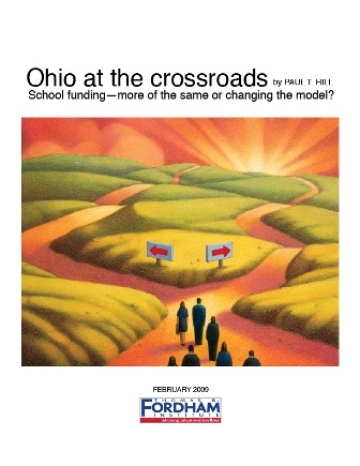
Ohio at the Crossroads: School funding—more of the same or changing the model?
Ohio Governor Ted Strickland's education plan calls for modernizing Ohio's K-12 education system, including the state's school-funding system, but the plan's so-called "evidence-based" approach would actually scuttle any modernizing efforts, argues this study issued by the Thomas B. Fordham Institute.

2007-08 Ohio Report Card Analysis
The Thomas B. Fordham Institute, in partnership with Public Impact, analyzed the 2007-08 academic performance data for charter and district schools in Ohio's eight largest urban cities.

Accelerating Student Learning in Ohio
As Gov. Ted Strickland concludes his 12-city "Conversation on Education" tour to gather ideas for reforming public education in Ohio, the Thomas B. Fordham Institute has put forth a report of five recommendations designed to keep improvements in the Buckeye State's public schools on track toward three critical goals: 1) maximizing the talents of every child; 2) producing graduates as good as any in the world; and 3) closing the persistent academic gaps that continue between rich and poor, and black and white and brown.
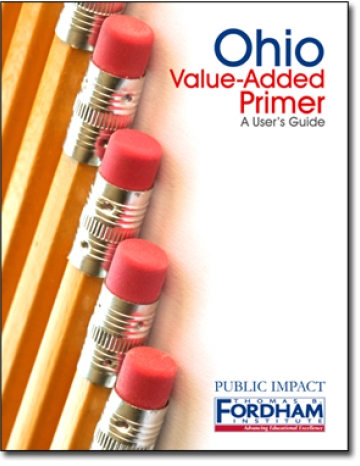
Ohio Value-Added Primer
Beginning in August 2008, Ohio's academic accountability system includes a value-added component that measures student academic progress in addition to achievement. Fordham created this short primer on value-added to help business people, lawmakers, policymakers, and others understand this powerful but complex tool.
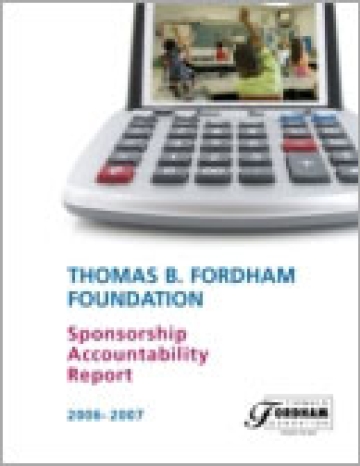
Thomas B. Fordham Foundation Sponsorship Accountability Report 2007
For information on Fordham's unique role as a charter school sponsor in Ohio, there's no better source than The Thomas B. Fordham Foundation Sponsorship Accountability Report 2006-07. The report offers a comprehensive account of Fordham's sponsorship policies and practices-as well as individual profiles of all Fordham-sponsored schools. Included in the profiles are descriptions of each school's educational program, school philosophy, and overall academic performance.

2006-07 Ohio Report Cards
Despite a decade of significant school reform efforts in Ohio, students in the state's largest cities still struggle mightily to meet basic academic standards and are nowhere close to achieving the goals set by the federal No Child Left Behind law, according to an analysis of the latest Ohio school report-card data.
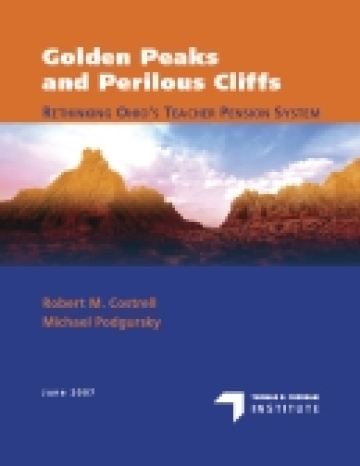
Golden Peaks and Perilous Cliffs
Despite its long history and prodigious size, all is not well with Ohio's teacher pension system. In this Fordham Institute report, nationally renowned economists Robert Costrell and Mike Podgursky illuminate some of the serious challenges facing STRS.
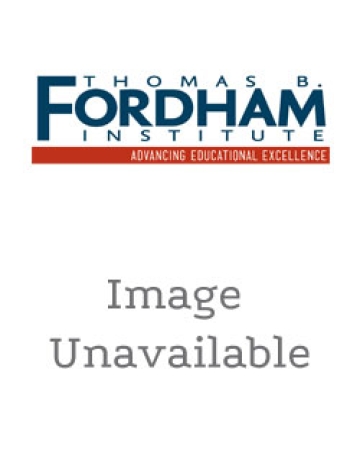
Ohioans' Views on Education 2007
This survey covers such topics as school quality and funding, academic standards, school reforms, proposals to improve how the public schools are run, teacher quality, charter schools and school vouchers. It follows up a survey conducted in 2005 and many of the questions are repeated, allowing us to gauge whether attitudes have shifted over time.
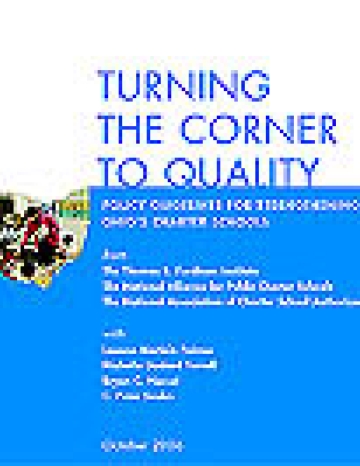
Turning the Corner to Quality
At the request of Ohio's top government and education leaders, the Thomas B. Fordham Institute, National Association of Charter School Authorizers, and National Alliance for Public Charter Schools have issued a report seeking to strengthen the state's charter school program. Among its 17 recommendations are calls for closing low-performing charter schools while also helping more high-performance schools to open and succeed in Ohio.
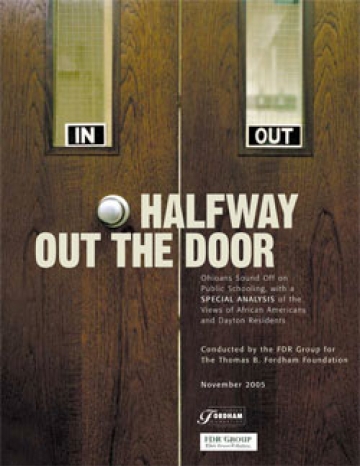
Halfway Out the Door
What do ordinary Ohioans think about the myriad education reforms enacted in the Buckeye state over the last half-decade? How do parents, taxpayers, and citizens view public schooling in 2005? Do they like these reforms? Seek more or less of them? Have confidence that they'll succeed? Fordham decided to enlist veteran analysts Steve Farkas and Ann Duffett to examine the attitudes of Ohio residents toward their public schools. The results? Ohioans are frustrated with their K-12 education system on a number of fronts, and feel the state is in dire need of stronger, better leadership when it comes to education. Policymakers would do well to pay attention.
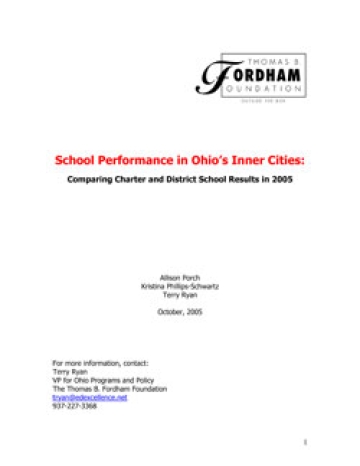
School Performance in Ohio's Inner Cities: Comparing Charter and District School Results in 2005
How are charter schools in Ohio truly performing when compared to their district counterparts? The latest Fordham Foundation report, School Performance in Ohio's Inner Cities: Comparing Charter and District School Results in 2005 provides a rare apples-to-apples comparison of charter school and district school achievement in four of Ohio's cities: Columbus, Cleveland, Cincinnati and Dayton. The results reveal that the performance of charter pupils isn't as dismal as Ohio's charter opponents want you to believe. However, the findings also illuminate the larger problem: ALL public schools in the Buckeye State still have a long way to go to reach academic success.

Testimony Prepared for the Alternative Education Subcommittee
On April 21, 2005, Fordham President Chester E. Finn, Jr. and Program Director Terry Ryan testified before the Alternative Education Subcommittee of the Ohio House of Representatives. They discussed Ohio's community schools (a.k.a. charter schools), which face a developing paradox: the more they expand and the more students they serve, the more threatened they become, by internal and external forces alike.